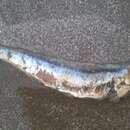Diagnostic Description
(
Inglês
)
fornecido por FAO species catalogs
Body slender, oval in cross-section, its depth about 5.5 times or more in standard length. Snout prominent, pointed, about 3/4 eye diameter; maxilla moderate, tip bluntly tapering or a little rounded, reaching to front margin of pre-operculum, extending a little beyond tip of second supra-maxilla; teeth in jaws small, numerous. Lower gillrakers 38 to 45, long and slender; no gillrakers on hind face of third epibranchial; pseudobranch long, reaching onto inner face of operculum. Anal fin short, with iii 17 to 20 finrays, its origin a little behind base of last dorsal finray. A broad silver stripe along flank, disappearing in adults. Anchoa marinii also has a long pseudobranch and just overlaps in anal finray count, but anal fin origin below midpoint of dorsal fin base; A. filifera and A. lyolepis have a long pseudobranch and a posterior anal fin origin, but like A. marinii have a longer and more sharply pointed maxilla (to or almost to hind border of pre-operculum); also, no species of Anchoa has more than 30 lower gillrakers.
- Acuña & Castello, (1986 - good summary of literature)
- Bellisio, López & Torno, (1979 - synopsis)
- Ciechomski, (1967a,b,c - a good synopsis, with some detailed information on breeding and feeding, also a number of further references to earlier work)
- citação bibliográfica
- FAO Species catalogue Vol. 7. Clupeoid fishes of the world. (Suborder CLUPEOIDEI) An annotated and illustrated catalogue of the herrings, sardines, pilchards, sprats, anchovies and wolf-herrings. Part 2. Engraulididae.Whitehead, P.J.P. 1985. FAO Fish. Synop., (125) Vol.7 Pt. 2:305-579.
- autor
- Food and Agriculture Organization of the UN
Distribution
(
Inglês
)
fornecido por FAO species catalogs
Western South Atlantic (from a little north of Rio do Janeiro at 22°S to San Jorge Gulf, Argentina, at about 47° S).
- citação bibliográfica
- FAO Species catalogue Vol. 7. Clupeoid fishes of the world. (Suborder CLUPEOIDEI) An annotated and illustrated catalogue of the herrings, sardines, pilchards, sprats, anchovies and wolf-herrings. Part 2. Engraulididae.Whitehead, P.J.P. 1985. FAO Fish. Synop., (125) Vol.7 Pt. 2:305-579.
- autor
- Food and Agriculture Organization of the UN
Size
(
Inglês
)
fornecido por FAO species catalogs
Reported to reach 22 cm total length, i.e., about 17 cm standard length.
- citação bibliográfica
- FAO Species catalogue Vol. 7. Clupeoid fishes of the world. (Suborder CLUPEOIDEI) An annotated and illustrated catalogue of the herrings, sardines, pilchards, sprats, anchovies and wolf-herrings. Part 2. Engraulididae.Whitehead, P.J.P. 1985. FAO Fish. Synop., (125) Vol.7 Pt. 2:305-579.
- autor
- Food and Agriculture Organization of the UN
Brief Summary
(
Inglês
)
fornecido por FAO species catalogs
Marine pelagic,coastal and to about 800 km or more from the shore;forming dense schools atabout 30 to 90 depth in summer off Argentina, but down to 100 to 200 m depth in winter (Bellisio, López & Torno, 1979:56).Feeds as juveniles on zooplankton (copepods, their eggs and larvae especially calanoids), but with phytoplankton becoming increasingly important. Spawns throughout year most intensely and close to shore in October/November and again but more offshore and less intensely in May/June (distinct spring and autumn spawners proposed by Fuster de Plaza, 1964; situation perhaps more complex according to Ciechomski, 1967a). Schools around southern Uruguay and northern Argentina move offshore toward the end of the year and northward in March to June, moving south again and close to shore in August to October.
- citação bibliográfica
- FAO Species catalogue Vol. 7. Clupeoid fishes of the world. (Suborder CLUPEOIDEI) An annotated and illustrated catalogue of the herrings, sardines, pilchards, sprats, anchovies and wolf-herrings. Part 2. Engraulididae.Whitehead, P.J.P. 1985. FAO Fish. Synop., (125) Vol.7 Pt. 2:305-579.
- autor
- Food and Agriculture Organization of the UN
Benefits
(
Inglês
)
fornecido por FAO species catalogs
Mainly exploited seasonally by small Argentinian fishing boats over the shelf, chiefly during the migration period September to October. The total reported catch for 1982 was 10 137 t, but according to Bellisio, López & Torno (1979:57) the annual sustainable catch could be increased to between 786 000 and 1 180 000 t. The most important gear are: purse seines, beach seines, lampara, ring nets, trap nets, gillnets. Some consumed fresh, the rest canned.The total catch reported for this species to FAO for 1999 was 18 912 t. The countries with the largest catches were Argentina (9 832 t) and Uruguay (3 193 t).
- citação bibliográfica
- FAO Species catalogue Vol. 7. Clupeoid fishes of the world. (Suborder CLUPEOIDEI) An annotated and illustrated catalogue of the herrings, sardines, pilchards, sprats, anchovies and wolf-herrings. Part 2. Engraulididae.Whitehead, P.J.P. 1985. FAO Fish. Synop., (125) Vol.7 Pt. 2:305-579.
- autor
- Food and Agriculture Organization of the UN

